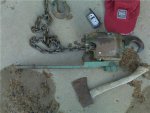You are using an out of date browser. It may not display this or other websites correctly.
You should upgrade or use an alternative browser.
You should upgrade or use an alternative browser.
Come-along
- Thread starter JIMBO
- Start date
jsmoriss
Explorer
slooowr6 said:Thanks for posting pic of the come-along!
Is 18lbs the weight of the main assembly or all the parts in the picture?
18 lbs is just for the main assembly. Everything together is about 34 lbs.
js.
jsmoriss
Explorer
jsmoriss said:18 lbs is just for the main assembly. Everything together is about 34 lbs.
I started weighing each piece and the steel cable (without the hook) is fairly light. The hooks are on the heavy side -- I'm thinking of keeping the steel cable, and replacing or removing the hooks in the future. Without it's snatch block, it weighs 27 lbs (see pictures bellow), which is not too bad considering it can pull 3 tons single-line... So I took it apart, and then put it back together again.



I'm not sure, but the difference between the 8000SB and 8000SBC might be just the snatch block. So I probably could have saved a few bucks by buying the 8000SB instead.
js.
michaelgroves
Explorer
jsmoriss said:According to Wyeth-Scott, they don't see why a synthetic line couldn't be used. So the only question that remains (before I order one), is 1/4" (9200 lbs strength) or 5/16" (13700 lbs) synthetic rope? Considering the Wyeth-Scott "Power Puller" can handle 4000 lbs with a snatch block, I'd tend to go with the 1/4" to put more rope on the reel... What do you think?
js.
Bit late on this, but it sounds to me like even the 1/4" synthetic rope is overkill in terms of strength. The winch can pull around 4000 lbs with snatch block, but that still only puts a 2000 lb load on the rope, so why would a rope rated at 9200 lb not be adequate???
Come-along Newbie Questions
Hi I am completely new to shopping for come-alongs. I want one for general farm applications (pulling combines onto trailers, etc).
Reading this thread, I've been pretty perplexed because I was about to buy a come-along from Harbor Freight. It's rated for 8,000 lbs, drag not lift, weighs 14 lbs, and only costs 30 bucks. http://www.harborfreight.com/cpi/ctaf/Displayitem.taf?itemnumber=543
Is this a total cheap-o that's not even worth the thirty bucks? Why is it so inexpensive (aside from reliance on semi-slave labor somewhere in the two-thirds world) and light-weight, compared to the units you guys have been talking about, but still claiming to be strong enough for 8 thousand pounds?
Thanks!
Hi I am completely new to shopping for come-alongs. I want one for general farm applications (pulling combines onto trailers, etc).
Reading this thread, I've been pretty perplexed because I was about to buy a come-along from Harbor Freight. It's rated for 8,000 lbs, drag not lift, weighs 14 lbs, and only costs 30 bucks. http://www.harborfreight.com/cpi/ctaf/Displayitem.taf?itemnumber=543
Is this a total cheap-o that's not even worth the thirty bucks? Why is it so inexpensive (aside from reliance on semi-slave labor somewhere in the two-thirds world) and light-weight, compared to the units you guys have been talking about, but still claiming to be strong enough for 8 thousand pounds?
Thanks!
jsmoriss
Explorer
Hi I am completely new to shopping for come-alongs. I want one for general farm applications (pulling combines onto trailers, etc).
This thread is more about using come-alongs as a replacement or in addition to a winch -- for side / rear pulls, etc. It sounds like you'll get more use out of yours than we would, but we would need more reliability for those cases when we do need it. So you might be shopping for similar specs...
Reading this thread, I've been pretty perplexed because I was about to buy a come-along from Harbor Freight. It's rated for 8,000 lbs, drag not lift, weighs 14 lbs, and only costs 30 bucks. http://www.harborfreight.com/cpi/ctaf/Displayitem.taf?itemnumber=543
Is this a total cheap-o that's not even worth the thirty bucks? Why is it so inexpensive (aside from reliance on semi-slave labor somewhere in the two-thirds world) and light-weight, compared to the units you guys have been talking about, but still claiming to be strong enough for 8 thousand pounds?
Manufacturers use different ratings. Some are rated to 8000 lbs before they break, others can pull 8000 lbs all day long. Also, most of the come-alongs discussed here are lift ratings. Pull ratings are open to all sorts of fudging (wheeled or not, in mud or not, etc.). You're better off comparing apples to apples (lift ratings to lift ratings, WLL to WLL).
To truly appreciate the difference, put them in your hands -- you'll understand the difference in quality very quickly.
js.
winkosmosis
Explorer
You can't use a Tirfor type hand winch with synthetic cable can you? Seems like if the jaws are made to grab steel, they'd crush and damage synthetic.
Thanks!
So, I guess one thing I could do is just purchase this one that I am looking at and use it to get some practice with come-along use, until it breaks. At this point, I am not at a stage where it is absolutely vital to my livelihood to have a reliable come-along, so it may be the perfect time to play around with something cheap, and figure out what I will really need. Does that sound sensible?
Any other recommendations on approach/brands, etc.
Brandon
So, I guess one thing I could do is just purchase this one that I am looking at and use it to get some practice with come-along use, until it breaks. At this point, I am not at a stage where it is absolutely vital to my livelihood to have a reliable come-along, so it may be the perfect time to play around with something cheap, and figure out what I will really need. Does that sound sensible?
Any other recommendations on approach/brands, etc.
Brandon
jsmoriss
Explorer
Any other recommendations on approach/brands, etc.
Have a look at the Maasdam come alongs - their catalog was mentioned earlier.
js.
michaelgroves
Explorer
Reading this thread, I've been pretty perplexed because I was about to buy a come-along from Harbor Freight. It's rated for 8,000 lbs, drag not lift, weighs 14 lbs, and only costs 30 bucks.
The "drag" rating is a total con. It's some hypothetical horizontal pull rating, plucked out of the air by the marketing team to make the thing sound more powerful/robust than it is.
The only meaningful figure is how much tension it can exert on the line (i.e. its vertical lifting capacity), and then only if that's qualified as being an ultimate load, or a WLL, or a SWL etc. Be aware thaat because the unit is supplied with a snatch block, any figures given will refer to a double line pull already.
michaelgroves
Explorer
You can't use a Tirfor type hand winch with synthetic cable can you? Seems like if the jaws are made to grab steel, they'd crush and damage synthetic.
Correct. Steel cable only in the tirfor types.
However, there's nothing to stop you using (and carrying) only a few metres of cable, and having the rest of your rigging synthetic. This would make the whole thing lighter and more manageable. You'd have to re-rig every five metres or so, but that's no biggie when you're working it all manually.
ntsqd
Heretic Car Camper
A simple search for the name within this thread didn't turn up any mention, so apologies if they were mentioned and my search missed them. I recently inherited a Coffing Hoist from my grandfather. I've used this particular hoist dating back to a wee child. My grandfather used it to do everything from a 5 ton truck's transmission R&R to tensioning fences. He even built an elevated rail system that used it to remove the engine from his GMC Motorcoach through the side door.
The particular hoist that I have is a G model, but I do not recall which size. I just used it last night to move a dead Scout II that has languished in my backyard. I moved it into the 'Deconstruction Zone' (as in its about to have a Sawzall Accident) with a flat tire. By myself I could not push or pull the vehicle on flat and level ground. I could rock it, but I could not make it move. Time to work smart instead of hard. The hoist didn't care about the flat tire and I couldn't tell as the handle effort was very low.
http://www.coffinghoists.com/assets/GModel.pdf
The length of hoist or pull isn't terribly long, but this particular unit came with an extender chain that would offer 12 to 15 feet of pull (I haven't ever seen it installed).
The particular hoist that I have is a G model, but I do not recall which size. I just used it last night to move a dead Scout II that has languished in my backyard. I moved it into the 'Deconstruction Zone' (as in its about to have a Sawzall Accident) with a flat tire. By myself I could not push or pull the vehicle on flat and level ground. I could rock it, but I could not make it move. Time to work smart instead of hard. The hoist didn't care about the flat tire and I couldn't tell as the handle effort was very low.
http://www.coffinghoists.com/assets/GModel.pdf
The length of hoist or pull isn't terribly long, but this particular unit came with an extender chain that would offer 12 to 15 feet of pull (I haven't ever seen it installed).
Last edited:
Stumpalump
Expedition Leader
I use that type of come along. I saw your post thought to inventory my recovery gear and snaped a few photos of it. Mine says 1.5 ton but thats an overhead lifting spec. If you want to know how much it will really pull then look at how one of the hooks bent. That hook is thicker than the one that came on my 9.5 K winch. I heated it to bend it back but you can see that it's still deformed.








Maasdam 4-ton come-along for 160 bucks-- a good deal?
My local hardware store has a Maasdam 4-ton come-along for 160 bucks.
Is it safe to assume that that is a dead-lift rating? Probably also assume that it is with the cable doubled up, right? I have been told that a come-along's pulling capability is roughly double its lifting capability, which means that the pulling rate with a single cable is roughly the same as the lifting rate with a double cable. Is that right?
160 bucks is more than I wanted to spend right now, since I have been buying a lot of equipment, but I have a feeling that this is a really great deal.
Any thoughts?
Brandon
My local hardware store has a Maasdam 4-ton come-along for 160 bucks.
Is it safe to assume that that is a dead-lift rating? Probably also assume that it is with the cable doubled up, right? I have been told that a come-along's pulling capability is roughly double its lifting capability, which means that the pulling rate with a single cable is roughly the same as the lifting rate with a double cable. Is that right?
160 bucks is more than I wanted to spend right now, since I have been buying a lot of equipment, but I have a feeling that this is a really great deal.
Any thoughts?
Brandon
jsmoriss
Explorer
My local hardware store has a Maasdam 4-ton come-along for 160 bucks.
I got mine here: http://www.torcarr.com/index.php?main_page=index&cPath=15&zenid=22290f5c50e1e3fc3ddbb2f92b35028f
So, yeah, $160 looks like a really good price.
js.
Similar threads
- Replies
- 8
- Views
- 3K
